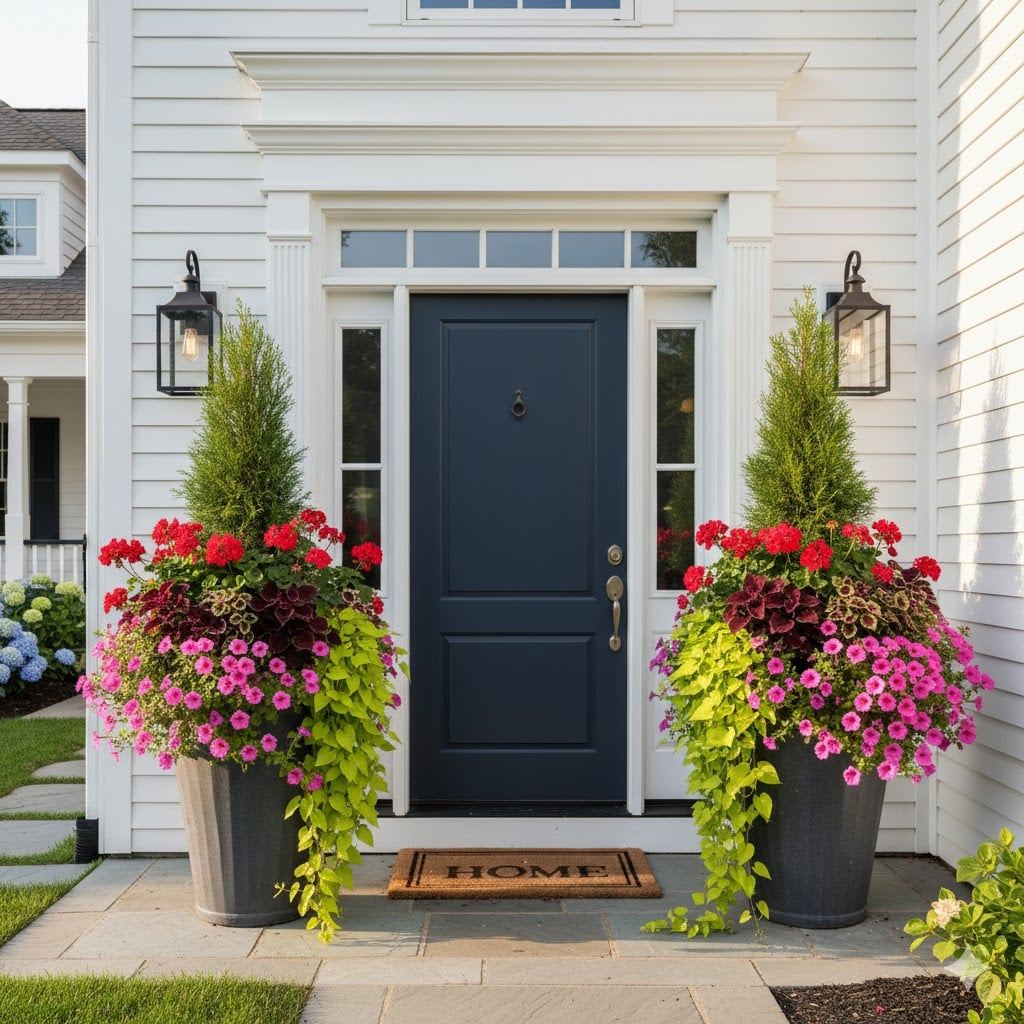What’s the secret behind those truly stunning front entrances you see? It’s not about expensive plants or complicated designs. I’ve found that the real secret to creating impressive, magazine-worthy tall planters is a simple formula that gardening professionals swear by: the Thriller, Filler, and Spiller method. In this comprehensive guide, I’m going to unlock that secret for you, sharing everything I’ve learned about designing, planting, and maintaining beautiful container gardens that make a statement.
Unlocking the Thriller, Filler, and Spiller Secret
The heart of every beautiful container garden is this simple design principle. It ensures that your arrangement has height, body, and a graceful flow. Think of it as building a small ecosystem within your pot, where each plant plays a vital role in the overall aesthetic.
The Thriller: The Statement Piece
This is the tall, dramatic plant that serves as the centerpiece of your planter. It’s the first thing the eye is drawn to, and it provides the necessary vertical interest that makes a tall planter so effective. When choosing your thriller, consider its form, texture, and how it will complement the architecture of your home.
- For Architectural Drama: If you have a modern home with clean lines, a spiky plant like Dracaena or Phormium (New Zealand Flax) can provide a striking, architectural look. Their sharp angles and bold colors, from deep burgundy to vibrant chartreuse, create a powerful visual contrast. I find that placing one of these on either side of a front door immediately gives a space a high-end, contemporary feel.
- For Classic Elegance: For a more traditional or cottage-style home, an evergreen like a Dwarf Alberta Spruce or a meticulously trimmed Boxwood topiary provides year-round structure. These are incredibly versatile; I love decorating them with string lights or festive ornaments during the holidays, making them a truly multi-seasonal anchor. They also work wonderfully as a pair, creating a sense of balance and symmetry.
- For Dynamic Color: For a burst of continuous color, a Hibiscus tree or a tall, flowering Rosemary standard can serve as a stunning, fragrant focal point. These are fantastic for a summer display, bringing a tropical or Mediterranean feel to your entrance. The key here is to choose a variety that thrives in your climate to ensure it blooms all season long.
The Filler: Building a Lush Foundation
The filler’s job is to fill the space around your thriller, adding volume and a lush, full appearance. These are typically bushy, mounding plants that act as the middle layer, connecting the height of the thriller to the trailing spillers. I always look for fillers that offer a contrast in texture or a complementary color to the thriller.
- For Reliable Color: You can never go wrong with Geraniums. They are incredibly tough and come in a wide range of colors from bright red to soft pink. They are perfect for sunny spots and their mounding habit quickly fills a large container. I’ve found that using one color of geraniums in multiple planters creates a cohesive, high-impact look.
- For Shady Spaces: If your front door is in a shaded area, Begonias and Impatiens are your best friends. Begonias offer beautiful, waxy foliage and delicate flowers, while Impatiens provide a continuous show of vibrant blooms, making a shady corner feel bright and welcoming. The ‘Dragon Wings’ Begonia, in particular, is a favorite of mine for its graceful form and long blooming season.
- For Bold Foliage: Don’t feel like you have to rely on flowers for color. Coleus is a true superstar when it comes to foliage. Its leaves come in an astonishing variety of colors and patterns—from fiery oranges to deep purples. I often use coleus to create a bold, modern arrangement that holds its color even without flowers.
The Spiller: Softening the Edges
The spiller is the final, essential element that cascades over the side of the planter, softening its hard edges and creating a sense of abundance and grace. This trailing element is what truly makes a container garden feel complete and professionally designed.
- For a Waterfall of Color: Trailing Petunias or Million Bells (Calibrachoa) are perfect for creating a dramatic waterfall of color. These plants are prolific bloomers and their long stems will spill beautifully over the edge of a tall pot. I’ve had great success with ‘Wave’ Petunias, which can quickly grow to cover a large area.
- For Rapid, Dramatic Trailing: Sweet Potato Vine is a fantastic choice for its large, dramatic leaves. It grows incredibly fast, and its chartreuse or deep purple foliage provides an amazing contrast against almost any other plant. I use it when I want a quick and impactful filler and spiller all in one.
- For a Subtle Touch: For a more understated look, Creeping Jenny offers a bright splash of lime-green foliage. It’s tough, beautiful, and its delicate stems add a lovely, flowing texture to any arrangement. It also pairs beautifully with both bold and subtle thriller and filler plants.
Beyond the Basics: Smart Strategies for Impressive Planters
Choosing the right plants is just the beginning. I’ve learned that a few extra steps in the planning and preparation stages can make a huge difference in the health and longevity of your planters.
Choosing the Right Pot
The planter itself is a major part of the design. Its material, color, and shape should complement your home’s aesthetic, but also serve a practical purpose.
- Material and Weight: While heavy ceramic or terracotta pots offer a classic look, I often opt for lighter materials like fiberglass, resin, or lightweight concrete. They have the same look but are much easier to move and are far more durable in harsh weather. This is especially important for tall planters that can be difficult to handle.
- Drainage is Key: This is a crucial, often overlooked detail. Your pot must have a large drainage hole at the bottom. Without it, water will collect and rot the roots of your plants. I always add a layer of gravel or small stones at the bottom of the planter before adding soil to improve drainage and prevent the hole from clogging.
The Secret to a Lighter, More Affordable Planter
Tall planters can require a massive amount of soil, which is both expensive and heavy. Here’s a secret I use to solve this problem: fill the bottom third to half of the planter with a lightweight, inert material. I often use old, empty plastic water bottles, soda cans, or even plastic nursery pots turned upside down. This reduces the amount of soil you need, makes the planter significantly lighter, and still allows for proper drainage.
Thinking Seasonally: Year-Round Beauty
The beauty of container gardening is that you can easily swap plants to reflect the changing seasons. Here’s how I keep my planters looking great all year:
- Spring: I kick off the season with a mix of early-blooming bulbs like daffodils and tulips, which I planted in the fall. I fill in the rest of the space with cool-weather annuals like pansies, violas, and primrose for a burst of cheerful color.
- Summer: This is when I really let loose with the Thriller, Filler, and Spiller formula, using all the vibrant, heat-loving plants like petunias, lantana, and ornamental grasses.
- Fall: As the weather cools, I swap out the summer plants for things like mums, ornamental cabbage, and kale. Their rich, earthy colors and unique textures are perfect for the autumn season.
- Winter: For the coldest months, I focus on evergreen plants. A pair of Alberta Spruces or a simple Boxwood can be adorned with red berries, pinecones, and lights for a festive, long-lasting display that doesn’t require constant watering.
Essential Care for Your Impressive Containers
Even the most beautiful arrangement won’t last without a little TLC. My last secret is that consistent care is what really separates an impressive planter from an average one.
Watering
This is the most critical part of container gardening. Since your plants are in a limited amount of soil, they will dry out much faster than those in the ground, especially on hot, sunny days.
- How I Check: I never water on a schedule. Instead, I stick my finger an inch or two into the soil. If it feels dry, I know it’s time to water.
- Water Thoroughly: When I water, I make sure to give the plants a long drink until water runs out of the drainage holes at the bottom. This ensures that the water reaches all the roots, not just the top layer of soil.
Fertilizing
Plants in containers are hungry. Since they can’t get nutrients from the surrounding soil, they need a steady supply of food.
- Start with a Boost: When I first plant my containers, I mix a slow-release granular fertilizer into the soil. This provides a steady stream of nutrients for several months.
- Liquid Feed: I supplement this with a balanced liquid fertilizer every two to four weeks during the main growing season to encourage robust growth and continuous flowering.
Maintenance
A little bit of regular upkeep goes a long way in keeping your planters looking their best.
- Deadheading: I make it a habit to remove spent flowers (a process called deadheading). This not only keeps the arrangement looking tidy but also encourages the plant to produce more blooms.
- Pruning: I regularly trim back any leggy or overgrown plants to maintain a full, neat shape. This prevents the planter from looking scraggly and keeps it looking fresh.
Now that you’re in on the secret, you have all the knowledge you need to create a stunning front entrance that truly stands out. Go ahead and start planning your perfect planter—I promise you’ll love the results.









